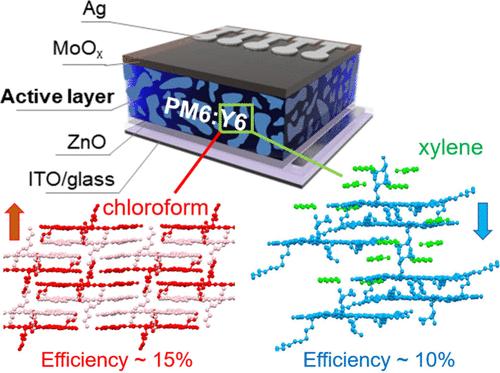溶剂诱导多态性对有机太阳能电池效率的影响
IF 18.2
1区 材料科学
Q1 CHEMISTRY, PHYSICAL
引用次数: 0
摘要
理解和减轻性能变化对于开发有机光伏(opv)非常重要,这通常是由半导体薄膜中分子实体的固态组织控制的。这就是实现结构性解决至关重要的原因。本研究揭示了经常隐藏的结构多态性如何深刻地影响体异质结opv的功率转换效率(PCE)。由低沸点氯仿(CF; PCE≈15%)和高沸点邻二甲苯溶剂(o-XY; PCE≈10%)铸成的PM6:Y6 BHJ层组成的器件表现出形貌依赖的光吸收、电荷输运和重组动力学。结合器件物理特性的协同多模态表征表明,溶剂和添加剂的保留会导致BHJ层的多晶化,从而导致性能变化。这些结果强化了绿色溶剂的选择不仅要考虑环境因素,而且要全面了解结构-性能之间的相互关系,这对提高opv材料的性能至关重要。本文章由计算机程序翻译,如有差异,请以英文原文为准。

Solvent-Induced Polymorphism Influences Efficiency in Organic Solar Cells
Understanding and mitigating performance variability are important for developing organic photovoltaics (OPVs), which are often governed by solid-state organization of molecular entities in semiconductor thin films. This is why achieving structural resolution is essential. This study demonstrates how often-hidden structural polymorphism profoundly influences the power conversion efficiency (PCE) of bulk heterojunction (BHJ) OPVs. The devices consisting of PM6:Y6 BHJ layers cast from low-boiling chloroform (CF; PCE ≈ 15%) and high-boiling o-xylene solvents (o-XY; PCE ≈ 10%) exhibit morphology-dependent optical absorption, charge transport, and recombination dynamics. A synergistic multimodal characterization combined with device physics reveals that the retention of solvents and additives leads to polymorphous BHJ layers, contributing to performance variation. These results strengthen the conclusion that green solvent selection should be guided not only by environmental considerations but also by a thorough understanding of structure–property interrelations, which are vital for improving material performance in OPVs.
求助全文
通过发布文献求助,成功后即可免费获取论文全文。
去求助
来源期刊

ACS Energy Letters
Energy-Renewable Energy, Sustainability and the Environment
CiteScore
31.20
自引率
5.00%
发文量
469
审稿时长
1 months
期刊介绍:
ACS Energy Letters is a monthly journal that publishes papers reporting new scientific advances in energy research. The journal focuses on topics that are of interest to scientists working in the fundamental and applied sciences. Rapid publication is a central criterion for acceptance, and the journal is known for its quick publication times, with an average of 4-6 weeks from submission to web publication in As Soon As Publishable format.
ACS Energy Letters is ranked as the number one journal in the Web of Science Electrochemistry category. It also ranks within the top 10 journals for Physical Chemistry, Energy & Fuels, and Nanoscience & Nanotechnology.
The journal offers several types of articles, including Letters, Energy Express, Perspectives, Reviews, Editorials, Viewpoints and Energy Focus. Additionally, authors have the option to submit videos that summarize or support the information presented in a Perspective or Review article, which can be highlighted on the journal's website. ACS Energy Letters is abstracted and indexed in Chemical Abstracts Service/SciFinder, EBSCO-summon, PubMed, Web of Science, Scopus and Portico.
 求助内容:
求助内容: 应助结果提醒方式:
应助结果提醒方式:


